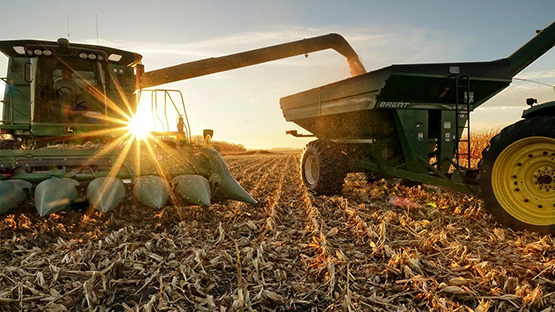
The long, cold trudge through Harvest 2019 continues; but it IS moving forward. This year has not been without its challenges. The good news is that each day we get a little closer to the end and that weather forecasts for the second half of November look decent. As far as the markets go, futures prices rallied nicely as we headed into that mid-October snowstorm before trailing off once harvest got going nationally. That’s true pretty much across the board. However, due to the fact that harvest has been slow, as well as some lingering questions about the state of the 2018 crop, basis levels have been quite respectable. That could be a big advantage for those who are able to get bushels out and it’s a huge opportunity for those who are still holding some 2018 crop in the bins.
USDA released their monthly World Agricultural Supply and Demand Estimates (WASDE) and Crop Production report on November 8th. The report had a few helpful parts, but overall wasn’t a huge market mover. The big news is that projected carryout of the 2019 soybean crop was cut in half from where we ended the 2018 year, but that wasn’t a huge shock due to the lower planted area, declining yields, and the fact that USDA had revised the size of the 2018 crop lower the month before.
| U.S. Ending Stocks (mbu) | Nov USDA | Trade Est | Oct USDA | 2018/2019 |
| Corn | 1.91 | 1.817 | 1.929 | 2.114 |
| Soybeans | 0.475 | 0.428 | 0.46 | 913 |
| Wheat | 1.014 | 1.035 | 1.043 | 1.08 |
| World Ending Stocks (mmt) | Actual | Trade Est | USDA Oct | 2018/2019 |
| Corn | 295.96 | 300.31 | 302.55 | 320.06 |
| Soybeans | 95.42 | 93.85 | 95.21 | 109.66 |
| Wheat | 288.28 | 287.03 | 287.8 | 277.9 |
Those numbers, while improved from last year, don’t highlight the fact that this market still has challenges. Demand for all three major crops is less than stellar with crush levels flattening to soft and corn exports struggling. Globally, economic growth is a weight and until we can get some sort of improvement it’s hard to see commodity markets as a whole taking off. The Chinese continue to struggle with African Swine Fever, and while that has opportunity for U.S. pork producers, it’s not helpful for soybean meal and corn demand in the short to intermediate term.
The more immediate questions most farmers have are much more basic. What do I do with grain that is wet, perhaps light, and suffers from any number of other issues due to the wet growing season? Those situations will never be addressed directly on a WASDE balance sheet, but it is apparent that 1) there are a significant number of bushels in the upper Midwest that may not be harvested until winter or even spring and 2) even on the bushels that have been harvested, there are quality issues - particularly in the wheat and corn crops.
These items are huge challenges to the farmers who have to sell them and to the market that has to sift out the value of those bushels. Further, there was and is no real way to protect against discount schedules. For both corn and wheat, the biggest hurdle for average to poor quality bushels is that it makes it more difficult to attract good export business. That is already being seen on the Pacific Northwest (PNW) corn market where demand for bushels year-to-date is slower than it has been in years. Part of it is price competitiveness: the slow harvest, as mentioned above, has boosted basis levels. It is also true that competing countries, such as Brazil and Argentina, are not short on bushels and at least to some extent, can fill in with “heavy” corn. That doesn’t mean all our demand is gone, just that price has to work harder to keep it.
The upside to this is that feed demand is likely to benefit. It’s not likely to be enough to offset lower exports, but it will dampen the downside pressure on cash prices, especially in feed deficit areas. Remember that feed is mixed in pounds, not bushels. Lower test weights mean more bushels have to be fed to generate the same amount of feed. Unfortunately, that’s doesn’t do much to buffer the discounts at the elevator or processor.
The main things to consider as we continue working through this challenging crop is that we have to operate on risk/reward. There are situations, especially this year, where there isn’t going to be a “good” choice - just a better one. These are the circumstances that define farms and managers over time, but they are also decisions that are extremely individual. For example, should I let corn stand until spring or continue trying to harvest and pay drying charges? That depends. Cash flow needs, extent of the moisture, drying ability, elevator charges/discounts, and the amount of crop you expect to lose if you let it stand, among other issues, are all things that need to be considered. Bring in a sample and have the merchandiser pencil out your effective price. Is that a price you can live with? Can you pay for holding those bushels through market carry, basis appreciation, or declining discounts? If you have questions on any of these things, don’t be afraid to reach out to someone whether it be your merchandiser, loan officer, insurance specialist, or someone else. Communication among all parties will be especially helpful.
Remember, while this year is tough, it’s not impossible. We have had years like this before. However, it’s been sometime since we’ve had to deal with it. If the stress is getting to be too much, please don’t be afraid to reach out and talk to someone. We’re all in this together. Here’s wishing everyone a safe harvest.



